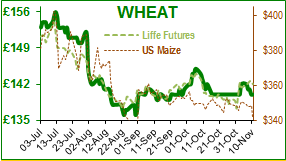Every harvest year is different to the previous, but this one is unique. As we have reported for several months there is a North-South divide, with wheat in the South valued at about £140/t, in Cheshire about £10 more, and the North-West at an additional £7/t!
UK May Liffe wheat futures have traded between £146-147/t all this week, but as a trading tool, London futures are useless (too cheap) for Northern traders who can only trade physical wheat, so that could partly explain the reduced open interest this year compared with previous years. In the South there are more wheat sellers than buyers, in the North the reverse is true, so we have the very strange situation where Kent wheat is being hauled up to Cheshire. Logic would dictate that Southern wheat should be put on a boat and shipped up North, but taking into account storage charges, haulage to/from ports, loading and unloading, it is cheaper to haul it; and as the UK is not exporting, it is a sensible use of otherwise-idle vehicles. The other option would be for the North to import from the Continent, but when priced in €, Matif wheat is €169.50, Liffe is €165.10 (May futures) not enough of a price difference to import. As to what could change this situation this harvest year, it is difficult to predict: a significant change in currency exchange possibly caused by a new ‘remain’ government; or a change in the economics of UK biofuel caused by Brexit are what-if scenarios that the grain trade is analysing.
Internationally, the Russians believe that they have harvested 88Mln T of wheat this year (76Mln T last year) and will be the world’s largest exporter of wheat this year, having shipped 13Mln T in Jul-Oct (10.6Mln T last year). Their wheat is also the cheapest in the world, making life extremely difficult for EU exporters. The Russians are also boldly taking a stab at Australia’s traditional customers, by shipping wheat to the Far East. Australia’s wheat harvest is almost complete in Queensland (top right of Oz) and the combines are rolling in New South Wales (bottom right). Overall they expect to harvest about 21Mln T (35Mln T last year) of which they are expected to export 18Mln T (22Mln T last year), Russians permitting.
The USDA report this week was relatively neutral on all our commodities, but the one surprise was US maize where they predict a yield of 175.4b/a - a new record high exceeding last year’s record. Analysts point to a number of factors to explain this including: spring rain and lack of extreme heat; better genetics; increased plant density and better crop recovery (improved combines). Consequently global ending stocks were increased by 3Mln T to 204Mln T, and US maize prices fell 6 cents/b to new contract lows.
The USDA estimates a US soyabean carryout of a comfortable 425Mln Bushels, with the US harvesting 120Mln T soya, Brazil 108Mln T and Argentina 57Mln T in 2017/18. They estimate China will import 97Mln T, leaving global ending stocks at a comfortable 98Mln T. All of which indicates that soya is likely to trade sideways unless/until there is a weather event in South America weather such as La Niña the probability of which has been increased to 65-75% (55-65% last month). There are reports that Trump’s current visit to China, has led to a commitment by China to buy more US soya but the volumes are undisclosed. Last year the US sold 38Mln T of soya to China (40% of its imports), and has sold 21Mln T this year to date (Jan-Sep) which is 15% more than the same time last year as the bulk of US soya exports seem to take place in the latter part of the year (post US harvest).
This year’s Ig Noble award for Anatomy (a parody of the Nobel Prize award) was GP James Heathcote. In 1993, he asked why old men have such big ears. He and his colleagues measured the ears of 206 patients over the age of 30, and discovered that ears grow by an average of 0.22mm per year, equivalent to 1cm over 50 years. His article was published in the British Medical Journal in 1995, and has since been confirmed by scientists around the world. His prize was a virtually worthless $100 trillion Zimbabwe banknote.
Yuya Yamada has just been awarded an entry in the Guinness Book of Records for the largest hula hoop spin, with a diameter of 5.14m (16ft 10in) aluminium hoop. The rule is that three full revolutions are required for the record.





















